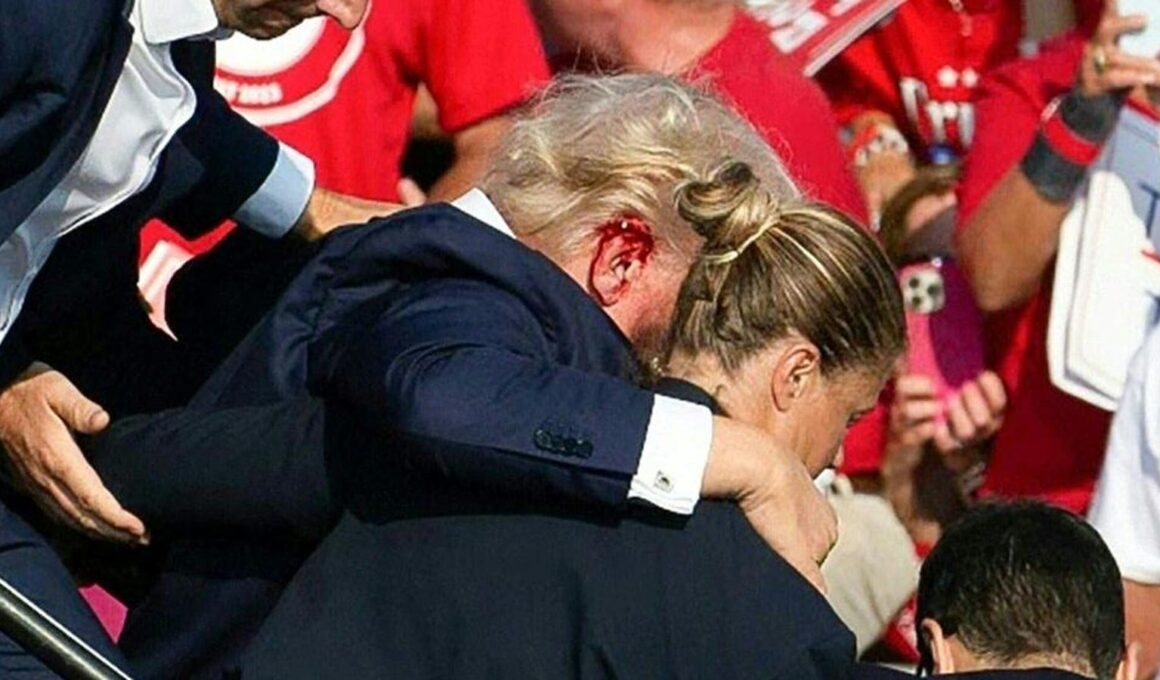Topline
Former President Donald Trump’s ex-physician on Friday rejected speculation from the director of the FBI that the GOP nominee could have been pierced by a piece of shrapnel instead of a bullet when a gunman attempted to assassinate him at a campaign rally earlier this month.
Speculation has gained traction in recent days that former President Donald Trump may not have been … [+]
Key Facts
Doctor Ronny Jackson, Trump’s former primary care physician, claimed there is “absolutely no evidence that it was anything other than a bullet,” citing an initial evaluation from Butler Memorial Hospital, the Pennsylvania hospital where Trump was treated after the assassination attempt.
Jackson’s statement comes in direct response to FBI Director Christopher Wray’s testimony before the House Judiciary Committee on Thursday, when Wray argued an ongoing investigation into the shooting earlier this month has not yet determined conclusively whether the former president was hit by a bullet or shrapnel.
In that statement, Jackson, a former Navy physician, said he “completely” concurs with that assessment, arguing Wray was “wrong and inappropriate to suggest anything else,” and urging Congress to “correct the record as confirmed by both the hospital and myself.”
Get Forbes Breaking News Text Alerts: We’re launching text message alerts so you’ll always know the biggest stories shaping the day’s headlines. Text “Alerts” to (201) 335-0739 or sign up here.
Chief Critic
Trump also took exception with Wray’s testimony, claiming the “FBI never even checked” what grazed his ear, claiming in a post on Truth Social there was no glass or shrapnel in his ear and adding: “it was, unfortunately, a bullet that hit my ear, and hit it hard.” Trump also took the opportunity to lay into Wray—a Trump appointee during his first year in office in 2017—for the FBI director’s testimony that he had not observed signs of President Joe Biden’s cognitive decline during his conversations with the soon-to-be outgoing president—Trump earlier this week called on Wray to resign over those comments.
Tangent
The question of what grazed Trump’s ear, leaving him bloody and bandaged, has become political in the two weeks since the shooting. In a statement earlier this week, the FBI said the agency “continues to examine evidence from the scene” and that its investigation “remains ongoing.” Following Wray’s testimony, however, several Republicans have shot back at the idea Trump could have been hit by something other than a bullet. House Speaker Mike Johnson, R-La., told NBC News after the House hearing “we’ve heard it from multiple sources in different angles that a bullet went through his ear.” Trump campaign spokesperson Steven Cheung said “it’s shocking” Wray “doesn’t know what the facts are, but that probably says more about his job performance—or lack thereof—than anything else.” A New York Times analysis, meanwhile, suggests Trump was likely hit by the first of eight bullets fired in his direction (the Times cited rally photos, video and audio and an analysis of bullet trajectory).
Key Background
Trump was grazed by gunfire while speaking at a July 13 campaign stop in Butler, Pennsylvania, a city north of Pittsburgh, just minutes after taking the stage. One man was killed by a stray bullet, while two others were seriously injured. Secret Service agents soon swarmed the president, who after falling to the ground was able to stand up, form a fist and appeato shout: “Fight.” In the aftermath of the shooting, however, the Secret Service and its director Kimberly Cheatle faced rounded criticism over how a gunman could ascend to a nearby rooftop and fire at the president. Cheatle later said she took “full responsibility” for the incident, and earlier this week, resigned from the Secret Service. Meanwhile, investigators have slowly pieced together details on the gunman, a 20-year-old identified as Thomas Matthew Crooks, who opened fire with an AR-style rifle and was fatally shot by Secret Service agents at the event. Crooks, a registered Republican who had previously donated to a Democratic organization, was not on the FBI’s radar, though the Secret Service classified him as “suspicious” at the rally. Before the assassination attempt, Crooks had searched for information on Trump, and had used a laptop to find out how far Lee Harvey Oswald was from former President John F. Kennedy when he fatally shot him in 1963, according to Wray.
Further Reading
“>








